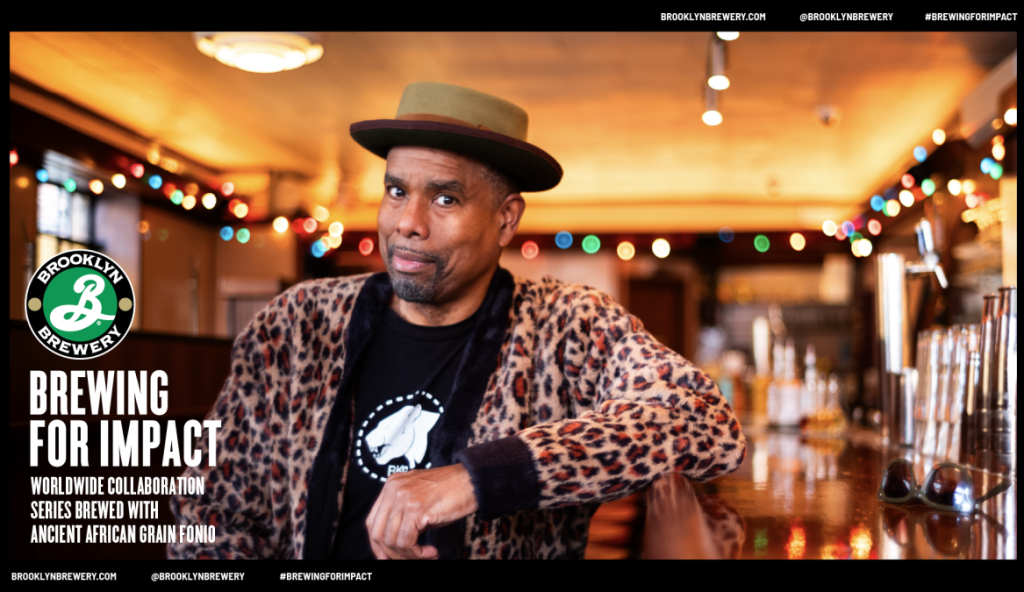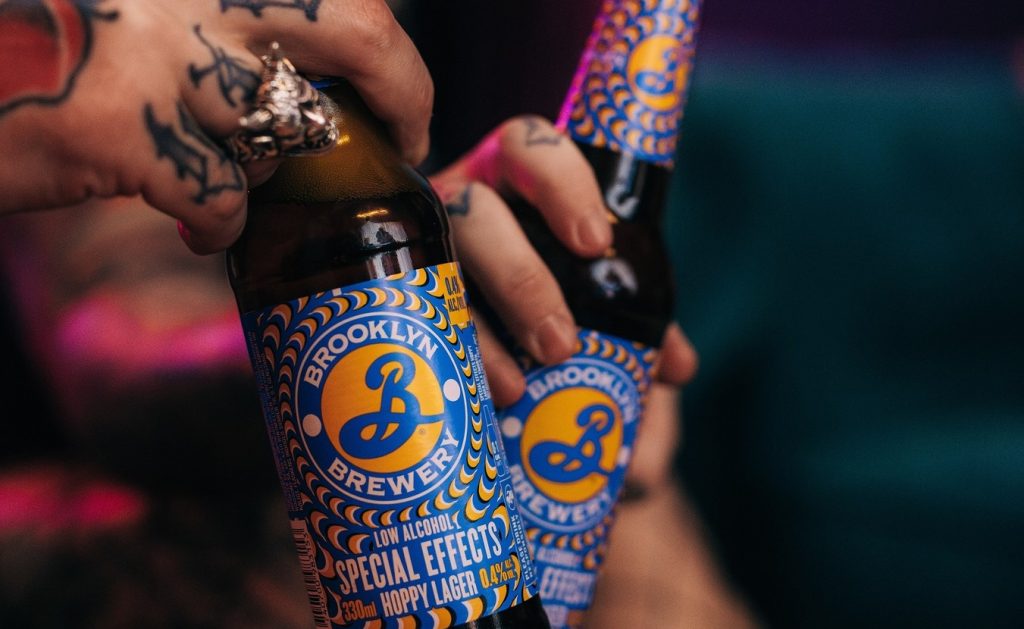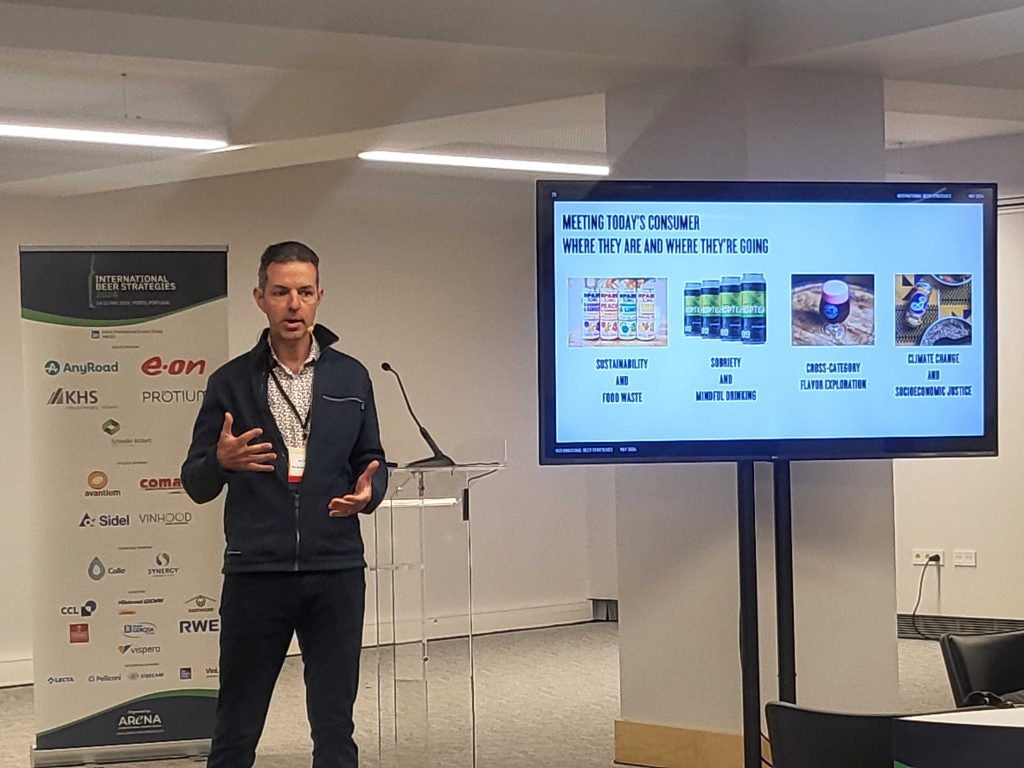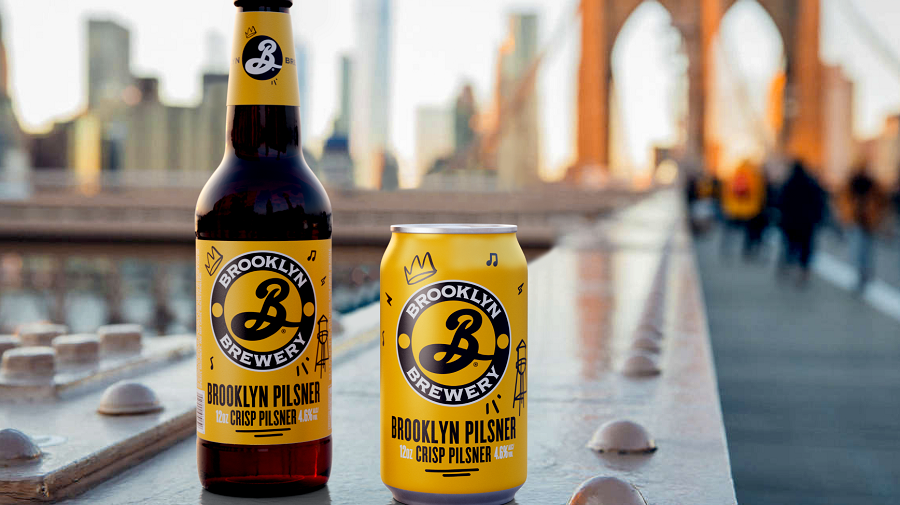Brooklyn Brewery has launched a campaign to promote a lesser-known, west African grain it believes can forge environmental change in the industry – fonio.
The US brewer hopes to encourage the use of fonio – which it says is drought-resistant and requires no irrigation, pesticides nor fertilisers.
A series of limited-edition beers have been launched with breweries from seven countries, including Diageo and Carlsberg, already a partner of Brooklyn in the UK.
Last week, Just Drinks caught up with Ottaway at the International Beer Strategies Conference held by our sister events arm Arena International to hear more about the project and what else is going on at the brewery.
Jess Broadbent (JB): What are you hoping will come of the Brewing For Impact project? Are you hoping the fonio beers will become permanent ranges?
Eric Ottaway (EO): What we're hoping to do is expose the brewing world and consumers to this incredible grain. Obviously, we would love it if brewers all over the world start brewing with fonio, whether on an experimental basis or even a permanent basis – and not used at 100%. Used at a 10% or 15% level it gives this really pleasant kind of fruity, slightly nutty note to the beer.
But what's more important, almost, is the impact that using that quantity of fonio can have on a part of the world that has been long neglected and frankly abused over the centuries by colonial powers, and re-empower local, family, often women-led, farms, to be more sustainable from an economic standpoint.
If we can help that entire sub-Saharan belt regain some control over their economic lives, we will have made an impact on the world.
JB: Does Brooklyn have any assets in west Africa, have you invested in anything there?
EO: Not directly ourselves, no. The best investment we can make is to help create a market for it.
JB: Are there any limitations or downsides to using fonio?
EO: None whatsoever. The only downside, if you will, and I wouldn't consider a downside, is that its flavour is unique, so you can't use it 100% if you want to create something that tastes exactly like beer. But, up to 15-20%, that actually becomes a really nice flavour adjunct.

Also, if you tried to use it 100%, you couldn't brew it in traditional brewing equipment, because it would clog everything up. It's a very fine grain. Used at that 10-20% level, it runs just like any normal ingredient.
JB: The cost of fonio is still higher than, say, barley. Will this push the cost of the final beer up?
EO: Yeah, it does make it a little bit more expensive but, when used in more of a specialty product that you can get a premium from, you can offset that. So we feel good about using it.
JB: You said a 100% fonio product tastes like a Sauvignon Blanc crossed with sake – would you ever release this within your cross-category products?
EO: Yeah, possibly! Obviously, we wouldn't sell it as a “beer” – or what you're used to drinking as a beer. We would have to figure out what to call it and where to place it as a product. But could we do that? Yeah. It's never going to be a very large product, obviously, because it's just too unfamiliar for people but, as a specialty product, sold at the brewery where you have the ability to talk to people and explain it.
JB: What about your other cross-category products that are only sold at the Brooklyn brewery site – are you looking to expand those?
EO: I think those actually have huge potential. We talk about this category “blurring”. I think people are looking for new, interesting products.
We have three beers (including Brooklyn Megapurple, a sour made using leftover grape matter and only available at the brewery’s bar) that really taste like sparkling wine.
From a taxation standpoint, there's also a huge advantage because beer is typically taxed almost everywhere at a much lower rate than wine or spirits. If we can essentially derive wine flavour from something that's technically a beer, that's a win-win.
JB: Would you see them sitting within the RTD category, flavoured beers or something else?
EO: That's a good question. You wouldn't sell it as a beer. Honestly, it would probably be closer to the RTD world. I don't think a retailer is ever going to stock it on the wine shelf but it would play in that [alternative packaging space], whether it's wine in a can or Tetra Pak for on-the-go beach, hiking, picnic occasions. That's where I could see that being super successful.
JB: Last week, the US federal government began consultations over easing cannabis restrictions – do you think Brooklyn would move into the THC category?
EO: Not unless things get totally legalised in the US. I think we're a long, long way away from brewers being allowed to use THC somehow.
It makes sense from a responsibility standpoint, not to mix two different intoxicating substances. First of all, there's no research on, or very little research on, how those two work together or don't work together.
I think it's unlikely, in my lifetime at least, that governments are going to allow THC and alcohol to be pre-mixed into beverages in and of themselves. How people want to consume them on their own is a totally different story.
JB: How about zero-alcohol beers?
EO: It's the same thing. Even though it technically doesn't have any alcohol in it, if it's labelled as a “non-alcoholic beer”, you're sort of in the same branch, if you will. So I don't think that's the right place to go.
JB: What is your outlook for your ‘Special Effects’ LoNo brand in the next few years? Do you see it becoming a big part of your sales?
EO: It's already almost 10% of our business in the US. I think that market is definitely going to continue to grow.
How big exactly the non-alcoholic market gets in the US is unclear. At the moment, it is still growing quite well but it's still only, like, a percent of the total market.
Will it ever become 5% or 10% like some European markets? It’s unclear. But what is clear is that with today's consumers, particularly the younger consumer, being much more mindful – both about their alcoholic intake but also about general healthiness – is that I think there will be an increasing role in lower alcohol, whether that's all the way to zero or just lower than traditional – that segment actually can become quite large.

Brewers are figuring out how to introduce flavour into lower-alcohol beer so it doesn't have to be this trade-off between alcohol and flavour, and I actually think that area could be could become huge.
Right now, in the US at least, there's this 4.2% almost like a Mendoza line, where all the light beers are 4.2% and they’re battling it out for who can create the lowest-calorie version of a 4.2%-alcohol beverage. You're starting to see a few people play below that a little bit – both AB InBev and Molson Coors are now talking about a 3.5% or 3.2% beer – which from a UK standpoint is not an unusual level but for the US is pretty radical. I think we're just at the very beginning of it.
How low it gets is going to be interesting to watch. The consumer seems to want some amount of alcohol in their beer, which is probably why 4.2%-abv kind of became the number that everybody decided was sort of like the minimum consumers wanted.
We have a beer that is literally just coming on tap right now, in the tasting room. That's at 3.5% and we're already experimenting with going lower even to, like, 2-2.5%-abv.
Light beer is a huge category in the US. So maybe an extra-light category develops?
JB: Is non-alcoholic beer on draught important in the US? It’s growing in the UK.
EO: Is it? It has not hit the US. I know there's one or two non-alcoholic breweries that have experimented with putting it on tap. One of the big issues in the US – because we have the three-tier system – is retailers are entirely independent. They're not allowed to have any monetary relationship with a supplier. So it's on the bar owner to maintain their own system – and non-alcoholic beers, from a quality standpoint, are difficult because they have a lot of leftover unfermented sugar in them. Staying on top of line cleaning and all that kind of stuff is a challenge.
The only other way to do it would be to put a lot of preservatives in the product. I’m not so clear the consumer’s going to be super excited about that.
JB: Outside of the US, in which markets does Special Effects have most potential?
EO: Sweden and the UK are the two biggest ones.
JB: What about for your wider portfolio – are there any growing or new markets you're looking at?
EO: Fortunately, we're growing in almost all of our international markets quite well. The only ‘major’ market that we haven't opened up yet is India.
I think in the next two years or so we'll probably enter that market. Obviously, there's a huge population [there] but they drink a lot of beer and ironically, actually drink strong beer, like 6%-plus. There's quite a strong connection with the US, so we actually think India can be quite an interesting market for us.
JB: Are you in discussions with distributors there yet?
EO: As you know, we work with Carlsberg in a number of markets and India is actually one of the ones that we'll be working with them as well. India can be a tricky market as it is so large, with state laws.
JB: How will you approach it?
EO: We will probably focus in one area to start with. Carlsberg has breweries around different states for that very reason – because you can't ship across state borders. So if we wanted to go into more states, we would utilise their various breweries. But I think we wouldn't start by doing a grand national launch. We would start in a very focused market and take it from there. We don’t know where yet.
JD: A Just Drinks columnist recently wrote a piece naming hazy IPAs as one of the main reasons US craft is becoming 'stagnant'. What are your thoughts on that?
EO: That’s an interesting thesis. I don't know that you can point to one style as being problematic for craft brewers, for causing market softness in the US.
There are almost 10,000 brewers in the US now so it is definitely an oversaturated market.
Now, to be fair, you've got to look behind the numbers: of those 10,000 brewers probably, 9,000 are virtually essentially tasting-room-only models.
But that still leaves an awful lot of packaging breweries. In any given market, there's 50 to 100 packaging breweries and craft brewers on the shelf.
There's no question that the market is overcrowded and oversaturated and I think it starts leading to consumer confusion. The world doesn't need another IPA.
The IPA has essentially become commoditised – that’s the problem. The expression I use is that IPA has become the new Chardonnay because, for decades now, you see it quite often, people roll up to the bar and look at this gigantic wine list and they panic. And they go: ‘Just give me a Chardonnay.’ Because they know what it is, they don't sound stupid asking for Chardonnay.
The same thing started happening with craft beer. And that's not good because then it becomes commoditised – when it's no longer the producer that matters, it's just the style.
There's no question the US market is overcrowded and oversaturated and it starts leading to consumer confusion. The world doesn't need another IPA.
That's the point where the US craft market has gotten to. It’s going to happen in any new market – the market is maturing. When that happens, brands start mattering more than ever. A lot of these craft brewers have grown not because they're well-established, differentiated brands, they're just growing because all of craft was growing.
Now all of a sudden, brands matter. And when you haven't done all the work of really establishing a differentiated brand, that's where it becomes a lot more difficult for some of these craft breweries to survive.

JD: What do you think is going to happen in the next five to ten years? Will we see consolidation?
EO: Yes, but probably not as much as people think, because so many of the models are essentially bars.
You need to be big enough or small enough. It's in the middle that’s really difficult. Because if you're small enough, you're got a handful of employees, you've got almost no overheads and you're capturing the entire margin from production all the way through to retail. You have a very different economic model. It becomes a lot easier to survive.
If you're in that 5,000 to 50,000 hectoliters range, you're too big to be small but too small to be big. That's a very difficult place to be in the market right now.
JD: How is inflation impacting the industry? Will that be a factor in the survival of smaller breweries?
EO: It's certainly been an issue and the cost of ingredients has gone way up. Along with everything else – cost of capital, kegs, custom packaging. But, again, you're more shielded from that if you're, essentially, a tasting-room model than if you're a packaging brewer because you're capturing so much of that value chain already.
The packaging brewers are the ones that are suffering the most because they have much more cost that's much more exposed to that inflation explosion.
JD: How do you see inflation impacting Brooklyn over the next 12 months?
EO: We're finding a lot of those inflationary pressures are starting to come down. For the first time in a long time, we actually got a price reduction from our can manufacturer. For a while post-Covid there was zero capacity in cans and so pricing went way up. The cost of malt is starting to come down again a little bit.
Wages are still way up, that's not going to change. Insurance has gone through the roof. The cost of machinery and equipment has gone up a lot. Fortunately, from a commodity standpoint, some of the main inputs are starting to come down. Energy has gone down a little bit as well. Natural gas prices have come down. Transportation cost is starting to go down as well.
JD: Might beer prices start to come down then?
EO: Unlikely. They'll stay up there because essentially brewers – and certainly craft brewers – were not able to capture back the total increase in cost through price increases, compared to other segments.
Craft-brew margins went down substantially in the post-Covid era and people haven't even come close to recovering. So the last thing that craft brewers can afford to do right now is cut their prices.
I think the bigger brewers were more able to offset their cost inflation, with price increases. But it's had a disproportionate impact on craft brewers because of the premium price we already have. There was this feeling that we couldn't go any higher, or we would effectively just kill off our market.
JD: Do you have concerns about the US election and how it could impact brewers?
EO: Personally, absolutely. From a business standpoint, it won’t really have an impact. Fortunately, presidents rarely have much of an impact on the economy – as much as they would like to take credit for or conversely not take blame for. There are so many other market forces at play.
JD: You’re moving the original Brooklyn brewery soon. What's happening there?
EO: The new brewery should be ready in the Fall of 2025.
We were the first brewery to open in Brooklyn post-Prohibition but that site was developed as a larger-scale production site over the years. We moved to Williamsburg because it was an industrial neighbourhood. Now it's becoming more and more residential, and to continue to operate that scale of a brewery in the middle of a residential neighbourhood just didn't make any sense.
We're downsizing the brewing side to an R&D brewery (with a 4-5,000-hectolitre capacity) and then upsizing the retail side so we can do much more with our tasting room and events, really using the facility as a marketing vehicle.
The majority of brewing has already been moved to upstate New York. We're moving four blocks away – so we’ve still got a home in Brooklyn.









